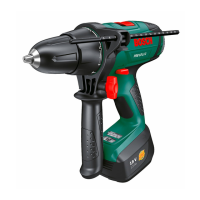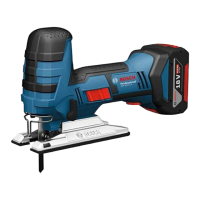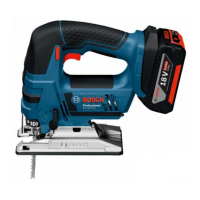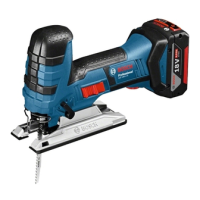– Retighten the screw (24).
Cut Control for miter cuts (see figure I)
To enable you to track the cutting line (Cut Control), the viewing window for Cut Control (16) has a mark (25) for
right-angled cuts at 0° and a mark (26) for rightward- and leftward-slanting miter cuts at 45° according to the scale
(23).
The cut mark for miter angles between 0° and 45° is proportional. It can also be marked on the viewing window for
Cut Control (16) using a non-permanent marker and easily removed again.
We recommend making a test cut for precise results.
Moving the base plate (see figure H)
You can move the base plate (10) back for sawing close to the edges.
Pull the saw blade storage compartment (9) out of the base plate (10). Loosen the screw (24) and push the base
plate (10) towards the extraction outlet (8) as far as it will go. Retighten the screw (24).
Sawing with an offset base plate (10) is only possible with a miter angle of 0°. In addition, Cut Control must not be
used with the base
(14), the parallel guide with a circle cutter (28) (accessory) or the anti-splinter guard (21).
Starting Operation
Switching on/off
To switch on the power tool, press the lock-off switch (1) first. Then press the on/off switch (2) and keep it pressed.
The work light lights up when the on/off switch (2) is lightly or fully pressed allowing the work area to be illuminated in
poor lighting conditions.
To switch off the power tool, release the on/off switch (2).
Note: For safety reasons, the on/off switch (2) cannot be locked; it must remain pressed during the entire operation.
Controlling the stroke rate
You can variably adjust the stroke rate of the power tool when it is on by pressing in the on/off switch (2) to varying
extents.
Applying light pressure to the on/off switch (2) results in a low stroke rate. Applying increasing pressure to the switch
increases the stroke rate.
The required stroke rate is dependent on the material and the work conditions and can be determined using practice
tests.
It is recommended that you reduce the stroke rate when placing the saw blade on the workpiece and when sawing
plastic and aluminum.
During prolonged periods of use at a low stroke rate, the power tool may heat up significantly. Remove the saw blade
and let the power tool run at the maximum stroke rate for around three minutes to cool down.
Temperature-dependent overload protection
In normal conditions of use, the power tool cannot be overloaded. If the power tool is overloaded or not kept within
the permitted battery temperature range, the speed is reduced or the power tool switches off. At reduced speed, the
power tool will run again at full speed once the permitted battery temperature is reached or the load is reduced. If it
automatically shuts down, switches the power tool off, allows the battery to cool down, then switch the power tool
back on.
The three LEDs in the battery charge indicator (3) flash quickly when the temperature of the battery is outside the
operating temperature range of −20 to +50 °C and/or the overload protection has been triggered.
Working Advice
Remove the battery from the power tool before carrying out work on the power tool (e.g. maintenance,
changing tool, etc.). The battery should also be removed for transport and storage. There is a risk of
injury from unintentionally pressing the on/off switch.
Switch the power tool off immediately if the saw blade becomes blocked.
When machining small or thin workpieces, always use a stable base or saw table (accessory).
Under certain conditions, strong electromagnetic fields can negatively affect or stop the power tool. After switching
the power tool off, press the on/off switch (2) again to restart the power tool.
Plunge cutting (see figure J)
Plunge cuts may only be applied to soft materials, such as wood, gypsum board, etc.
For plunge cutting, use only short saw blades. Plunge cutting is possible only with a miter angle of 0°.

